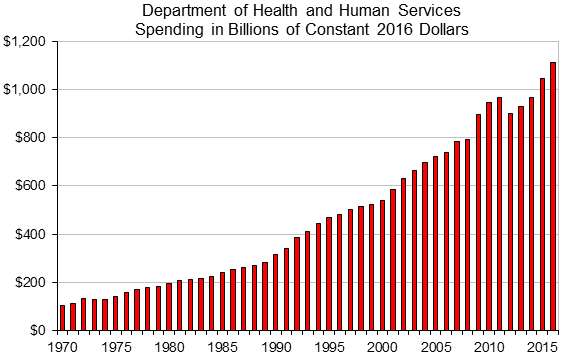The policy brief from the libertarian think tank that promotes climate skepticism — written by Heartland science director Jay Lehr — is something of a dream scenario for tea partiers and other conservatives, who would like a smaller government and a chance to wipe clean EPA’s federal regulations. Lehr writes that “incremental reform of EPA is simply not an option,” hence his proposal for a “Committee of the Whole” made up of state delegates that could slash 80 percent of EPA’s budget.
It’s hardly the first time conservatives have proposed trimming the government with an ax rather than pruning shears. Plenty of departments big and small have found themselves on the hypothetical chopping block for total elimination. Here’s a look at some of the proposals to clear out the Cabinet room.
Note: The buzzkills at the Congressional Budget Office said in a 2013 report that eliminating entire departments may not yield savings. “At best,” CBO wrote, “simply transferring programs to another department might reduce administrative support costs, but in most cases, such costs are much smaller than the costs of direct program activities.”
Commerce Department: An easy target for those hunting federal-department game, Commerce is always in someone’s sights. In 1995, the Department of Commerce Elimination Act cleared a committee in the Newt Gingrich-led House, and a 1996 nonbinding budget resolution that passed both chambers also called for eliminating the department. Under the 1995 bill, trade programs would have been consolidated under a new “Office of Trade,” while the National Oceanic and Atmospheric Administration would be parceled out to agencies like the Interior Department or Fish and Wildlife Service. President Obama may may have heard the calls — in 2012, he proposed moving NOAA to Interior.
Education Department: Another popular candidate for elimination. Ronald Reagan himself pitched the “deregulation by federal government of public education” as part of the 1980 Republican platform and its been a GOP calling card ever since. The American Spectator in 2012 proposed wiping the department away entirely and restoring its $68.1 billion budget to offset the deficit, while transferring its authority to states and local agencies.
Energy Department: The third agency Texas Gov. Rick Perry famously forgot he wanted to eliminate, Energy has also long been a pink-slip candidate. In his five-year budget plan, Sen. Rand Paul of Kentucky proposed zeroing out the department along with all of the grants and subsidies it distributes to renewable energy, while moving its nuclear research and the Atomic Energy Agency to the Defense Department. And in a 2011 bill, Republican Sen. Richard Burr of North Carolina offered up a plan to combine DOE and EPA into a new Department of Energy and Environment to eliminate any overlap.
Interior Department: During his 2012 presidential campaign, then-Rep. Ron Paul of Texas listed Interior as one of five federal agencies he’d eliminate. But what of the more than 500 million acres of public land managed by the agency? A year earlier he said this to the Western Republican Leadership Conference: “So you can imagine how wonderful it would be if land will be or should be returned to the states and then for the best parts sold off to private owners.”
Housing and Urban Development Department: At a closed-door fundraiser in 2012, GOP candidate Mitt Romney said that HUD, an agency his father helmed, “might not be around later” under a consolidation of the federal government. The American Enterprise Institute jumped on the proposal, saying HUD had helped distort the housing market. And in a column in Forbes, Josh Barro wrote that “there is nothing fundamentally unworkable about a private market in housing that requires heavy government regulation and subsidy” and said HUD should be shut down and housing subsidies abolished in favor of an expanded Earned Income Tax Credit.
Transportation Department: Daniel J. Mitchell of the Cato Institute has said that the volume of pork and bureaucracy should justify shutting down the federal Transportation Department in favor of state and local governments having power over roads. That way, he said, the gas-tax revenue wouldn’t be spent on “boondoggle mass transit projects.” Put more simply, Ron Paul said in 2012, the gas tax should just be collected and doled out to states by size or population. “And you could do that with one guy and a computer,” Paul said.
Agriculture Department: Greg Brannon, a doctor who sought the GOP nomination in North Carolina’s Senate race running under the tea-party mantle, made headlines earlier this year when he compared food stamps to “goodies” and said the program “enslaves people.” “The answer,” he said, “is the Department of Agriculture should go away at the federal level.”
Labor Department: The Cato Institute has offered up spending cuts for Labor, largely through reforming unemployment insurance. Others, including Fox Business host David Asman and Virginia Libertarian Party House candidate Will Hammer, have said the department should be axed entirely, with insurance and training being left up to the states.
Homeland Security Department: The Cato Institute’s David Rittger wrote in 2011 that DHS had become too bloated and “made it too easy for politicians to disguise pork barrel spending in red, white, and blue,” so he proposed restoring most of DHS’s responsibilities to their original agencies. Immigration, border security, and customs would be grouped under a new “Border Security Administration,” while the Transportation Security Administration and Federal Air Marshals Service would be axed completely.
